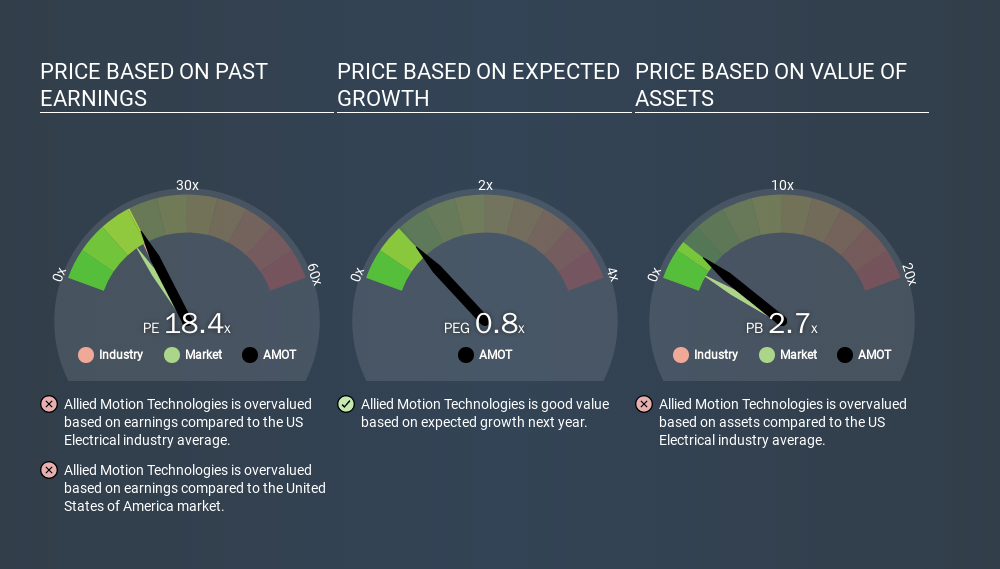- United States
- /
- Electrical
- /
- NasdaqGM:ALNT
How Does Allied Motion Technologies's (NASDAQ:AMOT) P/E Compare To Its Industry, After The Share Price Drop?

Unfortunately for some shareholders, the Allied Motion Technologies (NASDAQ:AMOT) share price has dived 31% in the last thirty days. Even longer term holders have taken a real hit with the stock declining 22% in the last year.
All else being equal, a share price drop should make a stock more attractive to potential investors. In the long term, share prices tend to follow earnings per share, but in the short term prices bounce around in response to short term factors (which are not always obvious). So, on certain occasions, long term focussed investors try to take advantage of pessimistic expectations to buy shares at a better price. Perhaps the simplest way to get a read on investors' expectations of a business is to look at its Price to Earnings Ratio (PE Ratio). A high P/E implies that investors have high expectations of what a company can achieve compared to a company with a low P/E ratio.
View our latest analysis for Allied Motion Technologies
How Does Allied Motion Technologies's P/E Ratio Compare To Its Peers?
Allied Motion Technologies has a P/E ratio of 18.40. As you can see below Allied Motion Technologies has a P/E ratio that is fairly close for the average for the electrical industry, which is 17.4.

Allied Motion Technologies's P/E tells us that market participants think its prospects are roughly in line with its industry. The company could surprise by performing better than average, in the future. Checking factors such as director buying and selling. could help you form your own view on if that will happen.
How Growth Rates Impact P/E Ratios
Earnings growth rates have a big influence on P/E ratios. When earnings grow, the 'E' increases, over time. That means even if the current P/E is high, it will reduce over time if the share price stays flat. So while a stock may look expensive based on past earnings, it could be cheap based on future earnings.
It's great to see that Allied Motion Technologies grew EPS by 19% in the last year. And it has bolstered its earnings per share by 8.8% per year over the last five years. So one might expect an above average P/E ratio.
A Limitation: P/E Ratios Ignore Debt and Cash In The Bank
One drawback of using a P/E ratio is that it considers market capitalization, but not the balance sheet. Thus, the metric does not reflect cash or debt held by the company. In theory, a company can lower its future P/E ratio by using cash or debt to invest in growth.
Such expenditure might be good or bad, in the long term, but the point here is that the balance sheet is not reflected by this ratio.
So What Does Allied Motion Technologies's Balance Sheet Tell Us?
Allied Motion Technologies has net debt equal to 36% of its market cap. While that's enough to warrant consideration, it doesn't really concern us.
The Verdict On Allied Motion Technologies's P/E Ratio
Allied Motion Technologies has a P/E of 18.4. That's higher than the average in its market, which is 14.7. While the company does use modest debt, its recent earnings growth is very good. Therefore, it's not particularly surprising that it has a above average P/E ratio. Given Allied Motion Technologies's P/E ratio has declined from 26.7 to 18.4 in the last month, we know for sure that the market is significantly less confident about the business today, than it was back then. For those who prefer to invest with the flow of momentum, that might be a bad sign, but for a contrarian, it may signal opportunity.
When the market is wrong about a stock, it gives savvy investors an opportunity. As value investor Benjamin Graham famously said, 'In the short run, the market is a voting machine but in the long run, it is a weighing machine. So this free visualization of the analyst consensus on future earnings could help you make the right decision about whether to buy, sell, or hold.
You might be able to find a better buy than Allied Motion Technologies. If you want a selection of possible winners, check out this free list of interesting companies that trade on a P/E below 20 (but have proven they can grow earnings).
If you spot an error that warrants correction, please contact the editor at editorial-team@simplywallst.com. This article by Simply Wall St is general in nature. It does not constitute a recommendation to buy or sell any stock, and does not take account of your objectives, or your financial situation. Simply Wall St has no position in the stocks mentioned.
We aim to bring you long-term focused research analysis driven by fundamental data. Note that our analysis may not factor in the latest price-sensitive company announcements or qualitative material. Thank you for reading.
About NasdaqGM:ALNT
Allient
Designs, manufactures, and sells precision and specialty-controlled motion components and systems for various industries in the United States, Canada, South America, Europe, and the Asia-Pacific.
Adequate balance sheet with moderate growth potential.
Similar Companies
Market Insights
Community Narratives





